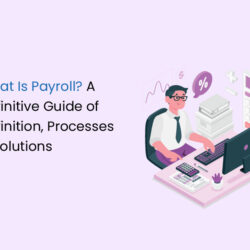The National Pension Scheme (NPS) in India stands as a voluntary and long-term investment plan designed for retirement, overseen by the Pension Fund Regulatory and Development Authority (PFRDA) and the Central Government.
In the latest update, the Central Board of Direct Taxes (CBDT) has introduced Form 12BBA, serving as a declaration form. Eligible senior citizens are required to submit this form to specified banks to avail relief from the necessity of filing the Income Tax Return (ITR). This recent development provides a streamlined process for senior citizens to access benefits and aligns with the ongoing efforts to simplify financial procedures. In light of these updates, it becomes increasingly important to explore the intricacies of the National Pension Scheme and its impact on retirement planning.
This insightful article sheds light on the nuances of NPS and its significance in the financial landscape. Read on to explore everything you need to know about the National Pension Scheme and how it works.
What is the National Pension Scheme?
The National Pension Scheme (NPS) stands as a crucial social security initiative orchestrated by the Central Government, extending its benefits to employees across various sectors – public, private, and even the unorganized sphere, excluding those in the armed forces. This pension program actively encourages individuals to invest in a dedicated pension account at regular intervals throughout their professional journey. Upon retiring, subscribers gain the flexibility to withdraw a specified percentage of the accumulated corpus. Subsequently, as an NPS account holder, you receive the remaining amount as a steady monthly pension post-retirement.
Initially designed exclusively for Central Government employees, the scope of the NPS has significantly expanded. As of now, the Pension Fund Regulatory and Development Authority (PFRDA) has extended its accessibility to all Indian citizens voluntarily. This inclusive approach broadens the horizon of retirement planning and financial security for individuals beyond the public sector.
The NPS scheme holds notable advantages, particularly for those in the private sector seeking a reliable pension stream post-retirement. One of its key features is portability, offering flexibility across different jobs and locations. Moreover, the scheme presents attractive tax benefits under Section 80C and Section 80CCD, making it a compelling choice for those mindful of their financial future.
Who Can Invest In It?
Choosing the National Pension Scheme (NPS) proves to be a wise choice for individuals keen on early retirement planning and possessing a conservative risk appetite. The allure of a steady pension income during the post-retirement phase is particularly advantageous, especially for those concluding their careers in the private sector.
Opting for a systematic investment approach through the NPS can wield a substantial impact on one’s life after retirement. The scheme’s appeal extends to salaried individuals aiming to optimise their tax-saving strategies through the available deductions under Section 80C. In essence, the NPS serves as a dual-purpose financial instrument, offering a secure retirement avenue while aligning with tax-saving goals for those conscientious about their financial well-being.
Benefits of the National Pension Scheme
The National Pension Scheme (NPS) offers a range of benefits that make it an attractive option for retirement planning.
Returns/Interest
A notable feature of the NPS is its allocation to equities, providing the potential for higher returns compared to traditional tax-saving investments like the PPF. With a track record spanning over a decade, the scheme has delivered annualised returns in the range of 9% to 12%. Additionally, investors have the flexibility to change their fund manager if dissatisfied with the fund’s performance.
Risk Assessment
To manage risk, the NPS imposes a cap on equity exposure, ranging from 75% to 50%. Government employees face a cap of 50%. The equity portion gradually decreases by 2.5% each year after the investor turns 50, offering a risk-mitigation strategy. For investors aged 60 and above, the cap remains fixed at 50%, providing stability amidst equity market volatility. This risk-adjusted approach contributes to the scheme’s appeal.
Regulated
Regulation by the Pension Fund Regulatory and Development Authority (PFRDA) ensures transparency in investment norms. Regular performance reviews and monitoring of fund managers by the NPS Trust add an extra layer of security, instilling confidence in investors regarding the management of their funds.
Flexibility
Flexibility is a key advantage of the NPS. Subscribers can contribute to the fund at any time during a financial year and adjust the subscription amount as needed. The freedom to choose from various investment options empowers investors to tailor their strategy to their financial goals. The ability to manage the account online, irrespective of changes in location or employment, enhances the overall convenience for subscribers.
Taxation Benefits on the National Pension Scheme
The taxation benefits differ for salaried and non-salaried workers, let’s break that down;
Employee Contributions
Employees contributing to the National Pension Scheme (NPS) can avail themselves of significant tax benefits. Under Section 80CCD(1), individuals can claim a tax deduction of up to 10% of their pay, which includes Basic and Dearness Allowance (DA). This deduction is subject to a maximum limit of Rs. 1.5 lakh under Section 80CCE. Additionally, an exclusive deduction of up to Rs. 50,000 is available under Section 80CCD(1B), further enhancing the overall limit to Rs. 2 lakh.
Employer Contributions
There are notable tax advantages for employer contributions to NPS on behalf of employees. The employer’s contribution is eligible for a tax deduction of up to 10% of the employee’s salary (Basic plus DA) under Section 80CCD(2). In cases where the Central Government contributes, the eligible deduction increases to 14% of the salary. This deduction is beyond the Rs. 1.5 lakh limit stipulated under Section 80CCE, offering an additional avenue for tax savings.
Tax Benefits for Self-Employed Individuals
Self-employed individuals participating in NPS can also enjoy tax benefits. Contributions made by self-employed individuals are eligible for a tax deduction of up to 20% of their gross income under Section 80CCD(1). This deduction operates within the total limit of Rs. 1.5 lakh specified under Section 80CCE. Furthermore, there is an additional deduction of up to Rs. 50,000 available under Section 80CCD(1B), enhancing the overall tax-saving potential to Rs. 2 lakh.
Tax Benefits on Partial Withdrawal
Partial withdrawals from the NPS account can be tax-exempt when the withdrawn amount is up to 25% of the self-contribution. This exemption is subject to the conditions and criteria specified by the Pension Fund Regulatory and Development Authority (PFRDA) under Section 10(12B). It offers individuals the flexibility to access a portion of their NPS funds without incurring tax liabilities, provided they adhere to the prescribed guidelines.
Tax Benefit on Annuity Purchase
Under Section 80CCD(5), tax exemption is granted on the purchase of an annuity or superannuation at the age of 60. It allows individuals to invest in annuity plans without facing tax implications at the time of purchase. However, it’s important to note that subsequent income generated from the annuity is taxable under Section 80CCD(3).
Tax Advantages of Lump Sum Withdrawal
Section 10 extends tax exemption on a lump sum withdrawal equivalent to 60% of the accrued NPS funds upon reaching 60 years or superannuation. This provision offers retirees the benefit of accessing a substantial portion of their accumulated corpus without being subjected to taxation.
Corporate/Employer Tax Breaks
Employers contributing to their employees’ NPS accounts can avail of tax deductions. The employer’s contribution, up to 10% of the employee’s salary (Basic + DA), qualifies as a deductible ‘Business Cost’ from the Profit & Loss Account under Section 36(1)(iv)(a). This incentivises employers to participate in their employees’ retirement planning through NPS contributions, aligning corporate and individual financial goals.
Understanding these tax benefits associated with NPS withdrawals and contributions provides individuals and corporations with valuable insights into optimising their financial strategies while ensuring tax efficiency. It underscores the multifaceted advantages the National Pension Scheme offers across various stages of retirement planning.
National Pension Scheme Withdrawal Rules After Retirement
Upon reaching the age of 60, individuals enrolled in the National Pension Scheme (NPS) can make withdrawals according to the following guidelines:
Lump Sum Withdrawal
- Subscribers are allowed to withdraw up to 60% of the total corpus as a lump sum.
- The remaining 40% must be utilised to purchase an annuity plan.
Entire Corpus Withdrawal (Up to Rs. 5 Lakh)
- If the total corpus is less than or equal to Rs. 5 lakh, subscribers have the option to withdraw the entire amount without purchasing an annuity plan.
- These withdrawals are tax-free, providing flexibility for individuals with smaller NPS savings.
Tax-Free Withdrawal Limit for Larger Corpus
- The tax-free withdrawal limit is capped for corpus amounts exceeding Rs. 5 lakh. For instance, if the corpus is Rs. 10 lakh, the tax-free withdrawal limit is Rs. 6 lakh.
- The remaining amount (in this case, Rs. 4 lahk) must be utilised to purchase an annuity plan.
Tax Treatment of Annuity
- While lump sum withdrawals are tax-free, the annuity received is subject to taxation based on the individual’s income bracket.
- If, for example, the annuity is worth Rs. 4 lakh, it will be taxed at the individual’s applicable income tax rate.
- The taxation is in accordance with the prevailing income tax bracket and is spread over the years of annuity payment.
These withdrawal rules aim to strike a balance between providing retirees with a lump sum for immediate financial needs and ensuring a steady income stream through an annuity plan. Understanding these implications can help one plan one’s finances more effectively during retirement.
Rules for Early Withdrawal and Exit
Upon reaching the age of superannuation or turning 60, National Pension Scheme (NPS) subscribers are obligated to allocate a minimum of 40% of their accrued pension corpus to the purchase of an annuity, ensuring a regular monthly pension. The remaining portion is then available for withdrawal as a lump sum, providing retirees with a degree of flexibility in managing their finances during retirement.
For those with a total accrued pension corpus less than or equivalent to Rs. 5 lakh, an attractive option exists – the ability to opt for a 100% lump sum withdrawal. This provision allows individuals with smaller NPS savings to access their entire corpus in a lump sum without the requirement of purchasing an annuity.
In cases of premature exit before reaching the age of superannuation or turning 60, a significant portion of the subscriber’s accrued pension corpus, namely 80%, must be directed towards the acquisition of an annuity, ensuring a steady monthly income. However, subscribers with a total corpus less than or equal to Rs. 2.5 lakh have the flexibility to choose a 100% lump sum withdrawal, providing immediate access to their funds in their entirety.
Upon the unfortunate event of the subscriber’s demise, the NPS facilitates a streamlined process for the transfer of financial benefits. In such cases, the entire accrued pension corpus (100%) is disbursed to the subscriber’s nominee or legal heir, offering financial support during challenging times. These rules underpin the NPS’s commitment to providing a comprehensive and flexible framework tailored to the diverse circumstances and needs of its subscribers.
Equity Allocation
In the National Pension Scheme (NPS), the allocation to equity, particularly under Scheme E, is subject to specific rules. Scheme E is the equity investment option within the NPS, and individuals have the flexibility to allocate a maximum of 50% of their investments to equities. This allocation serves as a risk management measure, as equity investments are inherently associated with higher volatility.
Investors in the NPS have two primary options for managing their equity allocation: auto choice and active choice. The auto-choice feature determines the risk profile of investments based on the subscriber’s age. Generally, the older the investor, the more conservative and less risky the investment strategy becomes. This approach is designed to align with the principle that as individuals age, they may prefer a more stable investment portfolio to safeguard accumulated funds for retirement.
On the other hand, the active choice empowers investors to make decisions regarding the specific schemes and the allocation of their investments. This option allows subscribers to customise their portfolio by actively selecting the schemes they wish to invest in and determining the distribution of their investments across different asset classes, including equities.
Changing Fund Manager or Scheme
In the National Pension Scheme (NPS), subscribers enjoy the flexibility to make changes to their pension scheme or fund manager if they are dissatisfied with the performance. This provision applies to both Tier I and Tier II accounts, offering subscribers the ability to tailor their investment strategy based on their preferences and the prevailing market conditions.
Whether a subscriber is enrolled in the mandatory Tier I account or the voluntary Tier II account, the option to switch pension schemes or fund managers provides a valuable tool for optimising their investment portfolio. This feature aligns to empower NPS participants to make informed decisions regarding their retirement savings and ensures that they have the ability to adapt to changing financial circumstances or investment preferences.
Eligibility for National Pension Scheme
The eligibility criteria for joining the National Pension Scheme (NPS) are as follows:
- Any individual, whether a resident or non-resident Indian (NRI), is eligible to join NPS.
- Overseas citizens of India (OCI), Persons of Indian Origin (PIOs), and Hindu Undivided Families (HUFs) are not eligible to subscribe to NPS.
- The prospective subscriber should be between the ages of 18 and 70 to join NPS.
- The individual must comply with the Know Your Customer (KYC) norms as outlined in the application form. This ensures that the necessary identification and verification processes are completed for the subscriber.
- The individual should be legally competent to execute a contract in accordance with the Indian Contract Act.
- NPS is an individual pension account, so it cannot be opened on behalf of a third person.
How to Apply for the National Pension Scheme?
Investing in the National Pension Scheme (NPS) involves a straightforward process regulated by the Pension Fund Regulatory and Development Authority (PFRDA). The NPS offers both online and offline methods to open an account.
Offline Process
- Locate a Point of Presence (PoP) registered with the PFRDA, which could be a bank or another designated institution.
- Obtain a subscriber form from the chosen PoP and submit it along with the necessary Know Your Customer (KYC) documents. If you are already KYC-compliant with that bank, you may skip this step.
- Make the initial investment, which should be no less than Rs. 500 or Rs. 250 monthly or Rs. 1,000 annually.
- Once the investment is made, the PoP will issue a Permanent Retirement Account Number (PRAN) and send it to you in a sealed welcome kit.
- Use the PRAN and password in the welcome kit to operate your NPS account. Note that this process has a one-time registration fee of Rs. 125.
Online Process
- Open an NPS account online at enps.nsdl.com, which is facilitated by the National Securities Depository Limited (NSDL).
- Link your account to your PAN, Aadhaar, and mobile number during the online registration process.
- Validate the registration using the One-Time Password (OTP) sent to your mobile number.
- A PRAN will be generated upon successful validation, which you can use for NPS login and account management.
Types of Accounts Under NPS
The National Pension Scheme (NPS) comprises two primary account types: Tier-I and Tier-II. The Tier-I account serves as the default option, while the Tier-II account is a voluntary addition. The table below delineates the distinctive features of these two account types:
| Particulars | NPS Tier-I Account | NPS Tier-II Account |
|---|---|---|
| Status | Default | Voluntary |
| Withdrawals | As per the rules/regulations | Permitted |
| Tax Exemption | Up to Rs 2 lakh p.a. (Under 80C and 80CCD) | 1.5 lakh for government employees; Other employees – None |
| Minimum NPS Contribution for Opening an Account | Rs. 500 | Rs. 1,000 |
| Minimum NPS Contribution | Rs. 500 per month or Rs. 1,000 p.a. | Rs. 250 |
| Maximum NPS Contribution | No limit | No limit |
The Tier-I account is mandatory for all individuals opting for the NPS scheme. Central Government employees are required to contribute 10% of their basic salary to this account. On the other hand, for individuals outside the Central Government, participating in the NPS is a voluntary investment option. The Tier-II account offers the flexibility of withdrawals, making it a voluntary and accessible addition to the NPS framework.
Interest Rate on NPS
The interest rate in the National Pension Scheme (NPS) is contingent upon the performance of its underlying assets. As a market-linked product, the returns received upon retirement cannot be predetermined. NPS allows investors to create a diversified portfolio by investing in a mix of equity, government debt, corporate debt, and alternative assets. Once the asset mix and fund manager are selected, the funds are invested in specific schemes representing these four asset classes.
NPS provides the flexibility of maintaining two types of accounts: Tier I and Tier II. The latest returns for NPS interest rates in both Tier I and Tier II accounts, as of December 31, 2022, are outlined below:
Returns on NPS Tier I
| Asset Classes | 1-year returns (%) | 5-year returns (%) | 10-year returns (%) |
|---|---|---|---|
| Equity (Class E) | 15.33-18.81 | 13.11-15.72 | 10.45-10.86 |
| Corporate Bonds (Class C) | 12.46-14.47 | 9.27-10.15 | 10.05-10.64 |
| Government Bonds (Class G) | 12.95-14.26 | 10.29-10.88 | 9.57-10.05 |
| Alternate Assets (Class A) | 3.98-16.73 | NA | NA |
Returns on NPS Tier II
| Asset Classes | 1-year returns (%) | 5-year returns (%) | 10-year returns (%) |
| Equity | 15.19-17.92 | 13.05-15.83 | 10.35-10.58 |
| Corporate Bonds | 12.71-16.36 | 9.55-10.17 | 9.86-10.60 |
| Government Bonds | 12.61-13.42 | 10.40-12.00 | 9.59-10.07 |
NPS vs. Other Tax Saving Schemes
Comparing the National Pension Scheme (NPS) with other tax-saving instruments such as the Public Provident Fund (PPF) and Tax-saving Fixed Deposits (FD) provides insights into their respective features:
| Investment | Expected Interest | Lock-in Period | Risk Profile |
|---|---|---|---|
| NPS | 9% to 12% | Till retirement | Market-related risks |
| ELSS (Equity Linked Savings Scheme) | 10% to 12% | 3 years | Market-related risks |
| PPF (Public Provident Fund) | 7.1% (guaranteed) | 15 years | Risk-free |
| FD (Tax-saving Fixed Deposits) | 5% to 7% (guaranteed) | 5 years | Risk-free |
While the NPS and ELSS offer the potential for higher returns, they come with market-related risks due to their exposure to equities. On the other hand, PPF and FDs provide guaranteed returns with a lower risk profile.
It’s essential to note that NPS may not be as tax-efficient upon maturity, as up to 60% of the accumulated amount can be withdrawn, of which 20% is taxable. It’s important to consider individual financial goals, risk tolerance, and tax implications when choosing among these tax-saving instruments. Additionally, tax regulations may change, affecting the taxability of NPS withdrawals. Investors should stay informed about any updates in tax laws that may impact their investment decisions.
NPS vs. ELSS
When comparing the National Pension Scheme (NPS) with Equity-Linked Savings Schemes (ELSS), certain key considerations come into play which have compared in the table below:
| Aspect | National Pension Scheme | Equity-Linked Savings Schemes |
|---|---|---|
| Equity Allocation | Limited, not as much as ELSS | Primarily focused on equities |
| Returns | Potentially lower returns from equity allocation in NPS | Potentially higher returns due to equity focus in ELSS |
| Lock-in Period | Longer (until retirement) | Shorter (3 years) |
| Risk Profile | Conservative to Moderate | Aggressive |
| Suitability for Risk-Seekers | May not be sufficient for aggressive risk-seekers in the long run | It serves investors with a higher risk appetite better |
For investors with an aggressive risk profile seeking higher equity exposure and potentially higher returns in a shorter period, ELSS might be more suitable. However, investors need to align their choices with their risk tolerance, investment horizon, and overall financial goals. Both NPS and ELSS serve as tax-saving instruments. Still, the differences in their investment strategies and lock-in periods may influence the preferences of investors based on their individual financial preferences and risk appetite.
How to Check Your NPS Account For The First Time?
To log into your National Pension Scheme (NPS) account for the first time, ensure you have a 12-digit Permanent Retirement Account Number (PRAN). If you don’t have one, submit the necessary documentation on the NSDL website or at the Point of Presence (POP) service providers to obtain your PRAN.
- Visit the official portal of NSDL CRA.
- On the NSDL CRA portal, locate the login section.
- Enter the following details:
- PRAN
- Date of birth
- New password
- Confirm password
- Enter the captcha
- After entering all the required details, click on the “Submit” button.
- Upon submission, an Internet Personal Identification Number (IPIN) will be generated. Take note of this IPIN as it will be used for logging into the NSDL portal.
- Log in to the NSDL eNPS page and click on ‘Login with PRAN/IPIN.’
- On the next page, use your PRAN and the generated IPIN to sign into your NPS account.
Following these steps will allow you to successfully log into your NPS account for the first time, providing you access to your NPS details and account information.
FAQs About National Pension Scheme
How much monthly pension will I get from NPS?
The monthly pension from NPS depends on factors like invested asset classes, investment duration, and contribution amount. Use the ClearTax NPS Calculator to calculate your monthly pension and tax benefits.
What is the NPS interest rate?
The NPS interest rate is not fixed and depends on asset performance. Return amounts upon retirement vary but typically range from 9% to 12%.
Which is better: NPS tier I vs tier II?
NPS Tier I is mandatory, and subscribers can opt for a voluntary Tier II account. Tier I is the individual pension account with tax benefits and withdrawal restrictions, while Tier II is a voluntary savings facility without tax benefits and withdrawal restrictions.
Can I withdraw money from NPS?
Yes, partial withdrawal is allowed after three years for specific reasons. After five years, you can withdraw a maximum of 20% as a lump sum, and at least 80% must be used to purchase an annuity. Complete withdrawal is allowed if the corpus is less than Rs.2.5 lakh.
What is the NPS scheme and its benefits?
NPS is a contribution pension scheme that allows retirement planning. It's regulated by the PFRDA, cost-effective, transferable, and offers tax benefits. Market-linked returns are based on subscriber investment choices, and online account access is provided.
Which scheme is best in NPS?
There are eight pension fund managers in NPS. Top-performing schemes include those managed by Aditya Birla Sun Life, HDFC, UTI Retirement Solutions, SBI, ICICI Prudential, Reliance, Kotak Mahindra, and LIC.
Who is eligible for the NPS scheme?
Any Indian citizen aged 18-70, including NRIs, is eligible. Legal competence as per the Indian Contract Act is required. PIOs and HUFs are not eligible.
What is the maturity period of NPS?
The NPS matures when the subscriber reaches 60 years of age. Contributions must continue until reaching this age, but partial or premature withdrawals are allowed.
What is the NPS Customer Care Number?
There are multiple ways of reaching the NPS, they are listed below;
- Call Centre: 1800 110 708
- SMS: Send NPS to 56677
- Toll-Free (Registered Subscriber): 1800 222 080





















